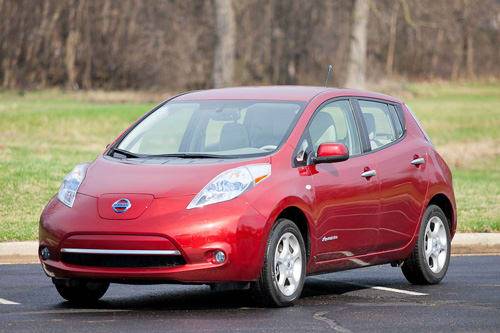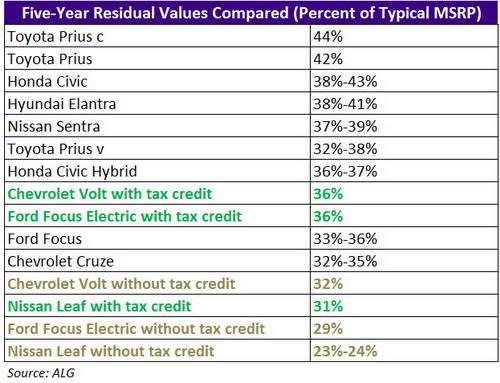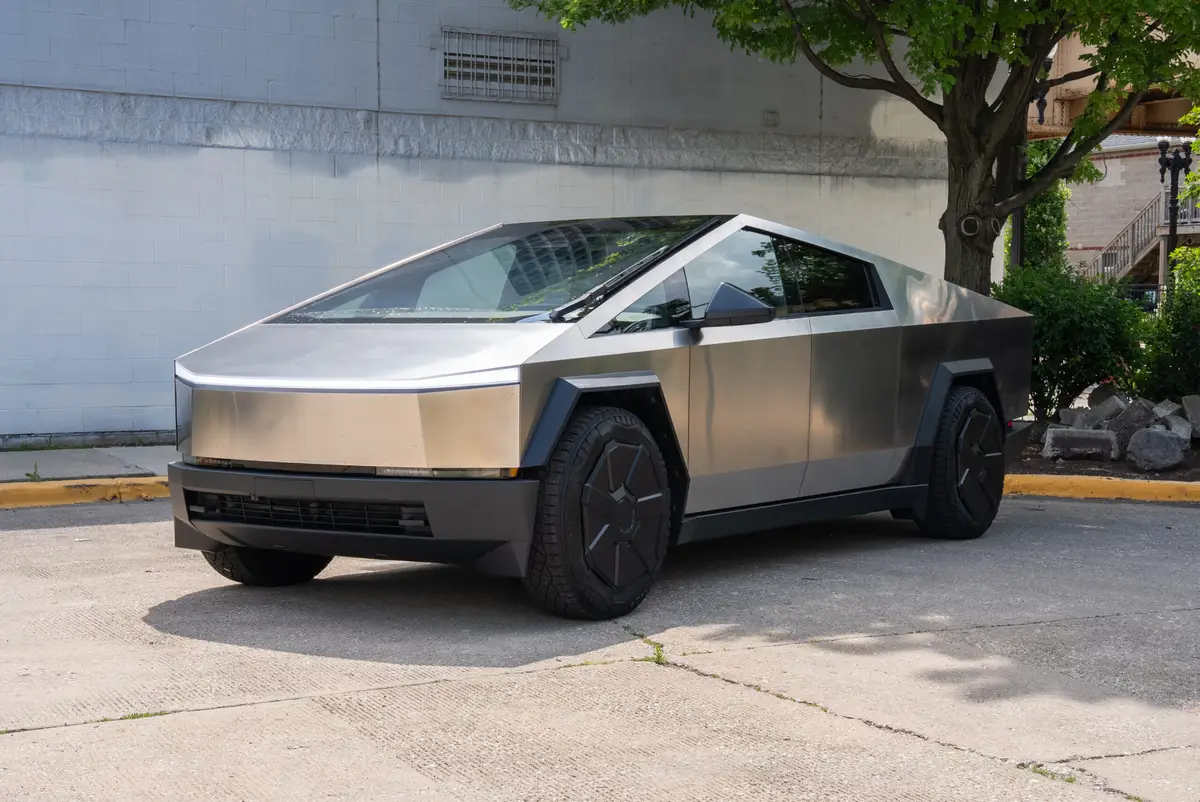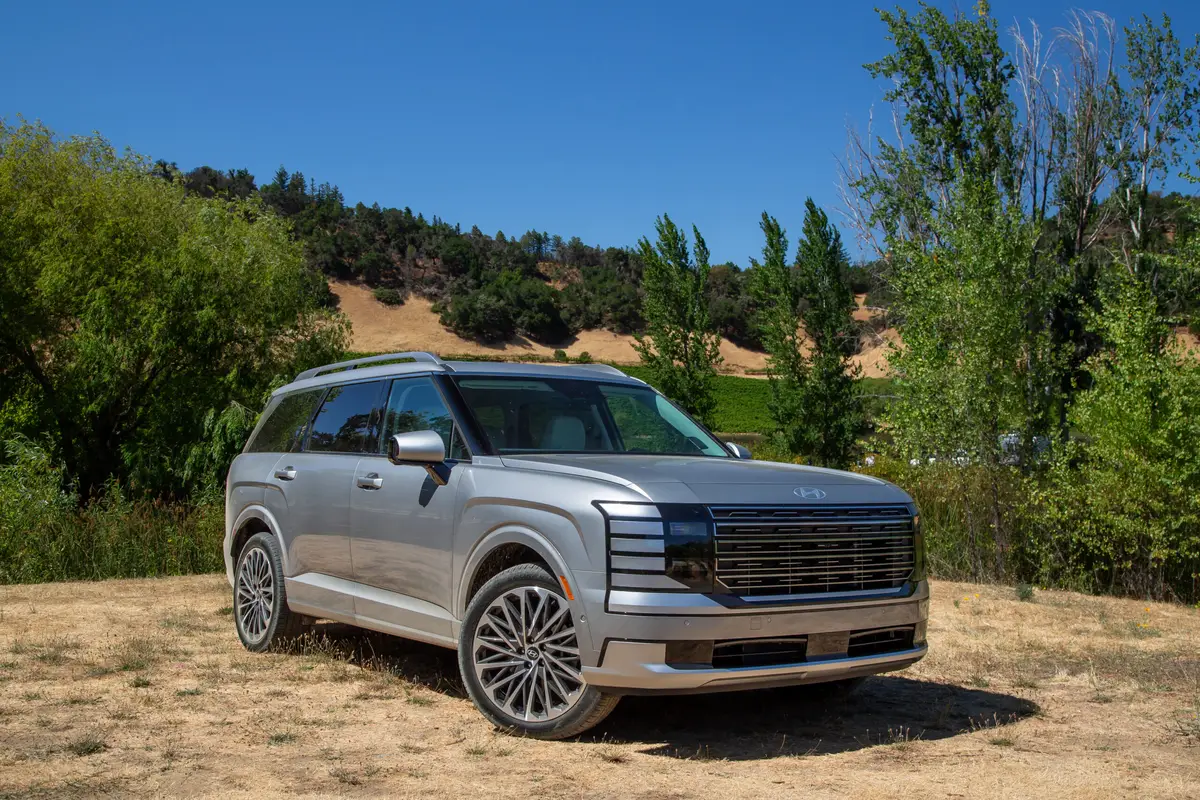Today's Electric Cars Could Sell for Less Tomorrow


When Nissan began taking reservations for the Leaf all-electric car in April 2010, Greg Tyler was among the first to plop down the $99 fee. Nineteen months later, the 59-year-old college professor was handed the keys.
“The Leaf was the most reasonably priced mass-market vehicle available,” said Tyler, of upstate New York, who calls himself “very satisfied” with his purchase.
Tyler is an early adopter, the sort of shopper that’s essential to any company with high-tech products. But early adopters face the inevitability of next-gen products doing more and costing less. It happens with consumer electronics all too often. Remember Apple’s iPhone 3GS? It used to run at least $199 with a cellphone contract. Two iPhone generations later, the 3GS is free with a contract.
It’s a small disappointment for consumer electronics shoppers, whose old gadgets end up as often in storage as they do on Craigslist. But resale value is serious business for car shoppers — and as fast as you can say “electric vehicle,” advancements have already rolled out.
Right about the time Tyler took the keys to his Leaf, Ford began selling its Focus Electric, whose higher-capacity hardware recharges the battery on a 240-volt charger in half the Leaf’s time. Nissan says the Leaf will support higher-capacity charging next year. No matter: Later this year, Honda will roll out the Fit EV, whose EPA-estimated 82-mile range bests both cars by six to nine miles. Even extended-range plug-in vehicles, like the Chevrolet Volt, are gaining ground. GM increased the Volt’s all-electric EPA range by three miles, or 9%, for 2013.
If tomorrow’s EVs drive farther and charge faster, who would pay much for today’s EVs?
Eric Lyman, who oversees automotive residual values at ALG, sees a risk but said it’s slight. “We sort of have versions of this in the traditional automotive sector as well, in terms of fuel economy,” he said. “It’s a little bit of a different concept because if you run out, you can always refuel. But effectively, it’s the same thing. It’s increasing your range.”
Still, Lyman says ALG is “more cautious than optimistic” with its forecasts on plug-in cars. A lot depends on getting the government’s $7,500 tax credit, which requires an equal tax liability. A used Leaf may fetch $10,000 down the road, but that’s a bigger percentage loss if it cost you the full $35,200 — or $27,700 after the tax credit.

Tax credit or no, current EV owners are staring at numbers below basic transportation, like the Honda Civic or Hyundai Elantra, if not high-mileage hybrids, like the Toyota Prius family.
Nissan spokesman Brian Brockman said the automaker is working on commercial applications for EV batteries after the life of the car, which could improve the value of EVs at the end of their drivable lifetime beyond just scrap metal. In the meantime, Brockman argues a pre-owned Leaf retains all its characteristics when new, and a “rapidly accelerating rollout” of infrastructure should build acceptance of the technology — and help resale value.
That may be true, but the infrastructure still has a long way to go. In a report released last month, the Energy Information Administration found just 14% of apartment dwellers — the urban demographic that many EVs target — have access to an electrical outlet within 20 feet of their parking spot. That needs to increase, and the pace of technological advances needs to remain slow, for EVs to retain resale value.
“Any leapfrog in technology is at least 10 years out or so,” Lyman said. ” I don’t necessarily think that the early adopters are going to suffer terribly because of that.”
Volt communications manager Michele Malcho agrees. “I don’t think you’re going to see as fast a change as we did with, for example, cellphone technology,” she says. “You’ll see continuous steps, but that dramatic jump in technology — from a resale-value standpoint, I don’t think it will be impacted.”
Even if a dramatic jump comes, it may not dry up the demand for today’s cars. Case in point: the Toyota Prius hybrid. Lyman pointed toward the first-generation 2001-03 Prius, a nameplate whose 2004 successor improved in myriad ways. Curiously, that didn’t leave the first Prius in the dust.
“We actually saw an increase in the used values of the first-generation Prius,” Lyman said. “If you had bought a Prius two months before the second generation launched, and held onto it for six months or so, you would’ve actually made money.
“Suppose the Leaf has the range to go all the way up to 160 miles,” he said. “And the demand goes through the roof for that vehicle. You may have a similar effect, where people just want the Leaf. A very successful second generation of a vehicle could actually positively impact the first generation.”
Not that it matters much to owners like Tyler. The professor plans to drive his Leaf into the ground, one 23-mile round-trip commute at a time.
“I intend to own it for a very long time, so I was just looking at total cost of ownership for 10 or more years,” Tyler said. “I originally bought the car because I’m cheap — because I wanted to save money on [gas]. And it’s been great for that.”
Related
Research Plug-in Vehicles
Find Used Cars
More Automotive News
When Nissan began taking reservations for the Leaf (1) all-electric car in April 2010 (2), Greg Tyler was among the first to plop down the $99 fee. Nineteen months later, the 59-year-old college professor was handed the keys.
“The Leaf was the most reasonably priced mass-market vehicle available,” said Tyler, of upstate New York, who calls himself “very satisfied” with his purchase.
Tyler is an early adopter, the sort of shopper that’s essential to any company with high-tech products. But early adopters face the inevitability of next-gen products doing more and costing less. It happens with consumer electronics all too often. Remember Apple’s iPhone 3GS? It used to run at least $199 (3) with a cellphone contract. Two iPhone generations later, the 3GS is free with a contract.
It’s a small disappointment for consumer electronics shoppers, whose old gadgets end up as often in storage as they do on Craigslist. But resale value is serious business for car shoppers – and as fast as you can say “electric vehicle,” advancements have already rolled out.
Right about the time Tyler took the keys to his Leaf, Ford began selling its Focus Electric (4), whose higher-capacity hardware recharges the battery on a 240-volt charger in half the Leaf’s time. Nissan says the Leaf will support higher-capacity charging next year. No matter: Later this year, Honda will roll out the Fit EV (5), whose EPA-estimated 82-mile range bests both cars by six to nine miles. Even extended-range plug-in vehicles, like the Chevrolet Volt (6), are gaining ground. GM increased (7) the Volt’s all-electric EPA range by three miles, or 9%, for 2013.
If tomorrow’s EVs drive farther and charge faster, who would pay much for today’s EVs?
Eric Lyman, who oversees automotive residual values at ALG, sees a risk but said it’s slight. “We sort of have versions of this in the traditional automotive sector as well, in terms of fuel economy,” he said. “It’s a little bit of a different concept because if you run out, you can always refuel. But effectively, it’s the same thing. It’s increasing your range.”
Still, Lyman says ALG is “more cautious than optimistic” with its forecasts on plug-in cars. A lot depends on getting the government’s $7,500 tax credit, which requires an equal tax liability (8). A used Leaf may fetch $10,000 down the road, but that’s a bigger percentage loss if it cost you the full $35,200 – or $27,700 after the tax credit.
Five-Year Residual Values Compared (Percent of Typical MSRP)
Toyota Prius c 44%
Toyota Prius 42%
Honda Civic 38%-43%
Hyundai Elantra 38%-41%
Nissan Sentra 37%-39%
Toyota Prius v 32%-38%
Honda Civic Hybrid 36%-37%
Chevrolet Volt with tax credit 36%
Ford Focus Electric with tax credit 36%
Ford Focus 33%-36%
Chevrolet Cruze 32%-35%
Chevrolet Volt without tax credit 32%
Nissan Leaf with tax credit 31%
Ford Focus Electric without tax credit 29%
Nissan Leaf without tax credit 23%-24%
Source: ALG
Tax credit or no, current EV owners are staring at numbers below basic transportation, like the Honda Civic or Hyundai Elantra, if not high-mileage hybrids, like the Toyota Prius family.
Nissan spokesman Brian Brockman said the automaker is working on commercial applications for EV batteries after the life of the car, which could improve the value of EVs at the end of their drivable lifetime beyond just scrap metal. In the meantime, Brockman argues a pre-owned Leaf retains all its characteristics when new, and a “rapidly accelerating rollout” of infrastructure should build acceptance of the technology – and help resale value.
That may be true, but the infrastructure still has a long way to go. In a report (9) released last week, the Energy Information Administration found just 14% of apartment dwellers – the urban demographic that many EVs target – have access to an electrical outlet within 20 feet of their parking spot. That needs to increase, and the pace of technological advances needs to remain slow, for EVs to retain resale value.
“Any leapfrog in technology is at least 10 years out or so,” Lyman said. ” I don’t necessarily think that the early adopters are going to suffer terribly because of that.”
Volt communications manager Michele Malcho agrees. “I don’t think you’re going to see as fast a change as we did with, for example, cellphone technology,” she says. “You’ll see continuous steps, but that dramatic jump in technology – from a resale-value standpoint, I don’t think it will be impacted.”
Even if a dramatic jump comes, it may not dry up the demand for today’s cars. Case in point: the Toyota Prius hybrid. Lyman pointed toward the first-generation 2001-03 Prius, a nameplate whose 2004 successor improved in myriad ways (10). Curiously, that didn’t leave the first Prius in the dust.
“We actually saw an increase in the used values of the first-generation Prius,” Lyman said. “If you had bought a Prius two months before the second generation launched, and held onto it for six months or so, you would’ve actually made money.
“Suppose the Leaf has the range to go all the way up to 160 miles,” he said. “And the demand goes through the roof for that vehicle. You may have a similar effect, where people just want the Leaf. A very successful second generation of a vehicle could actually positively impact the first generation.”
Not that it matters much to owners like Tyler. The professor plans to drive his Leaf into the ground, one 23-mile round-trip commute at a time.
“I intend to own it for a very long time, so I was just looking at total cost of ownership for 10 or more years,” Tyler said. “I originally bought the car because I’m cheap – because I wanted to save money on [gas]. And it’s been great for that.”

Former Assistant Managing Editor-News Kelsey Mays likes quality, reliability, safety and practicality. But he also likes a fair price.
Featured stories


2025 Tesla Cybertruck Review: Wedge Issues


2026 Hyundai Palisade Review: Growing Gains

